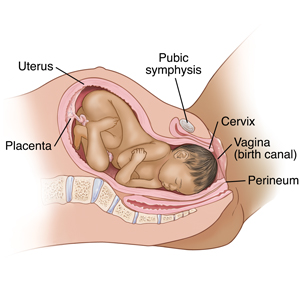Vaginal Birth: Your Experience
You’re almost ready for the big event—your baby’s birth. Once your cervix becomes fully dilated, you can begin pushing. At this point, you may have a burst of energy. The delivery itself may take a few contractions or a few hours. If your baby needs help getting out of the birth canal, your healthcare provider can assist.
Getting ready to push
The shortest but most intense part of labor is transition. This is when the cervix becomes fully dilated. Contractions may become even stronger. They may last 60 to 90 seconds, with almost no rest in between. This is a demanding time. You might experience hot flashes, chills, nausea, vomiting, or gas. Intravenous (IV) pain medicines are also rarely given so close to your baby’s birth. But epidurals are continued during birth. Help yourself by working with your support person or labor coach. You may feel an urge to push or bear down. But don't push until your healthcare provider or midwife tells you to.
Pushing toward birth
After your baby’s head enters the birth canal, contractions may come less often. Pushing down with the contraction helps move your baby further into the birth canal. If you’ve had a cesarean section in the past, your labor will be managed to help prevent tearing the scar.
Your baby’s birth
Once your baby’s head passes under the pubic symphysis, your perineum starts to stretch and bulge. Soon, the top of your baby’s head crowns (appears at the vaginal opening). You may have a burning feeling as this happens. Your healthcare provider or midwife may tell you to pant. This is so you won’t push too hard and tear your perineum as the baby’s head and shoulders come through. (A small amount of tearing is not rare and isn't a problem.) Your baby is born soon after the shoulders leave the birth canal. The umbilical cord is then cut.
 |
| Once the head and shoulders appear, your baby is ready to be born. |
Assisted delivery
Your baby may need extra help getting out of the birth canal. If so, you may have any of these to assist the birth:
-
An episiotomy. This is a small incision in the perineum. This enlarges the vaginal opening and is used if your baby needs to be delivered quickly. A local anesthetic may be used to numb the area. After your baby is born, the incision is closed with stitches. These are often dissolvable.
-
Forceps. These are spoon-shaped tools that cup the baby’s head. They may be used to help guide your baby’s head through the birth canal.
-
Vacuum extraction. This method uses a small suction cup attached to the baby’s head. This is done to help guide the baby through the birth canal.
After your baby’s birth
After the baby is born, the placenta is delivered. Mild contractions separate it from the uterus and move it into the vagina. Then you push it out. Your healthcare provider or midwife may press on the uterus to expel blood clots. If you had an epidural anesthetic, the catheter is removed.
Support person’s note
-
Help the pregnant person into a pushing position. Support their body as they push. A semi-sitting or semi-squatting position allows gravity to assist the birth.
-
Remind them to rest between contractions.
-
Encourage them by telling them when the baby’s head appears.
-
Keep in mind that you may be masked and gowned for the birth, depending on hospital policy.
Online Medical Reviewer:
Donna Freeborn PhD CNM FNP
Online Medical Reviewer:
Marianne Fraser MSN RN
Online Medical Reviewer:
Tennille Dozier RN BSN RDMS
Date Last Reviewed:
3/1/2024
© 2000-2024 The StayWell Company, LLC. All rights reserved. This information is not intended as a substitute for professional medical care. Always follow your healthcare professional's instructions.